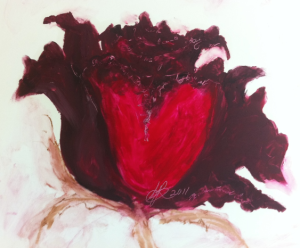
This is possibly the single thing I love most in the world. I cannot quite explain why, but when I look at it I am filled with love. I don’t get to look at it often, because it’s safely folded away in a cupboard, waiting for the day I have a room of my own where I can hang it and gaze at it whenever I want to. But just knowing that it is there is reassuring and I have created an imagined future centred around creating a life where I am surrounded by that wall hanging and all the other things I love.
All around the world, the last few weeks have centred around the frantic acquisition of things to give as gifts. Will those things be loved? Will they be valued? Some things are useful, even essential. But we don’t love them. We don’t feel a fullness in our hearts when we look at them. So why do some things move us? Why do we have to possess them?
We often characterise the desire for possessions as crass materialism and often that’s exactly what it is but it is also true that the desire to possess things that we love is endemic to humanity. History has been driven as much by the desire to have beautiful things as it has by the need to expand territory and extract resources. Art is the creation of the artist but also — in a way — the person who buys it and owns it too. Whoever created this and then owned it must surely have loved it:

I first saw that wall hanging in a curio shop in Hoedspruit. My response to it was immediate, visceral. I had to have it. It was R2 000 I did not need to spend — in fact it was horribly extravagant — and yet it never crossed my mind that I would not possess it. There was something about the colours, the purple and the intense blue, the creatures in it, the exuberance of the design; that it was crafted by a woman who sewed in all that detail. She must have had pride in her work, love even, because something that intricate and beautiful cannot have been created without love.
There are other things — some are possessions, some not — that I love too. Some because they are beautiful, some because they represent freedom, some because I feel that they help define me in a way that I like.
There’s the laptop on which I’m writing this blog and uploading it, my two-year-old 13-inch MacBook. Not the fastest or the best but it’s mine and it represents all the potential novels I will write. It’s a symbol of both freedom and creativity, the ability to work from anywhere and earn a living. (Funnily enough, I don’t feel the same about my iPhone.)
A book, The Truth in Masquerade, which is about my favourite historical figure, Francois Le Vaillant. It’s out of print and I was lucky to find it.
A print of an old map of Africa which hangs above my bed.
A bead and wire bull I bought from a Zimbabwean called Godfrey and which is the most perfectly judged representation of the animal that I’ve ever seen in this medium.
My giant carved chicken, the one in my profile picture.
Some of my own paintings because I created them and they capture something of the feeling I was hoping to evoke, like this one:

Or this one:

And yes, my car, which isn’t my car (in case this isn’t clear to any of you, it’s sponsored so I don’t own it — I just get to drive it thanks to the very generous people at Land Rover and an unbelievable amount of luck). I love it because it is expensive and it codes for status (and people in the parking lot at Monte Casino leave fingerprints on the glass) but mostly because it is beautiful. The design moves me: the way the line of the windows rakes toward the rear, the solidity of its stance from one angle, the way it manages to look as though it is moving when it is standing still from another. I am filled with a certain ineffable satisfaction every time I look at it and every evening I lay a hand on the bonnet in gratitude for all that it represents.
Is it wrong to love things? No, provided (obviously) that we don’t love them more than conscious beings or ideas that matter, and we keep in mind that things are always only the physical manifestation of the concepts behind the surface, whether it’s gleaming metal or painted wood or simply bright cotton.
But love them we do. It’s part of what makes us human.


